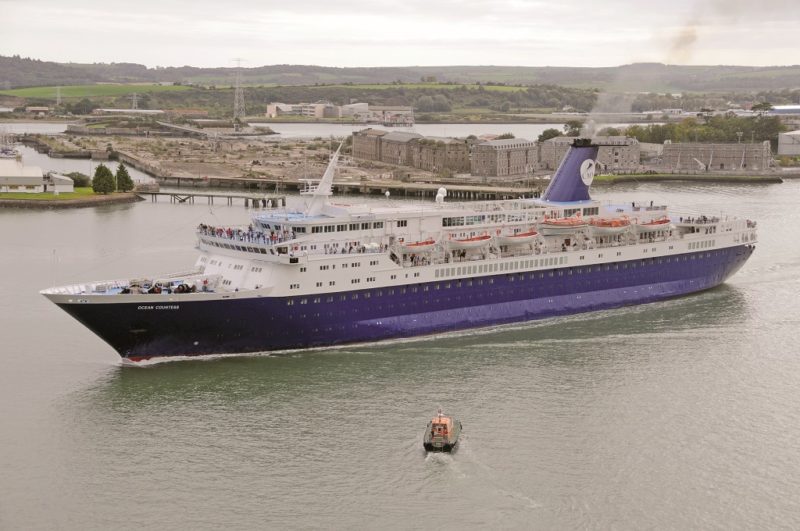
The Port of Cork is a vibrant, modern port spread out over a number of square miles of Southern Ireland, and encompassing a very wide Harbour Entrance, the Lower Harbour comprising Cobh Roadstead, Whitegate Oil Terminal, Haulbowline Island, Spike Island, the Ringaskiddy ro-ro berths, and the West Passage leading northwards to Cork Harbour and then west to the River Lee and the Tivoli Dock Estate and the Cork City Quays. It is a key seaport for Southern Ireland and also encompasses the famous Whiddy Island Oil Terminal on Bantry Bay over fifty miles to the west overland or longer by sea.
The Victorian resort of Cobh to south of Cork has one of the largest natural deep water ports in the world, and the second largest by navigable area. There are ro-ro, lo-lo, breakbulk, and dry bulk berths and the Cobh Cruise Terminal, European ro-ro trades by two well – known ferry companies, and a Transatlantic service to Philadelphia. Key developments are planned to increase annual port traffic of exports and imports to well above the present 11.0 million tonnes today.
The River Lee runs through Cork having risen in the Shehy Mountains on the border of West County Cork, and splits in two channels, North Channel and South Channel, at Cork creating an island on which the City of Cork was built. The international Cork Airport is five miles west of Passage West, and a hydro-electric scheme lies upriver from Cork with the Iniscarra and Carrigadrohid dams and reservoirs. The River Lee is crossed by 42 bridges of which 29 are crossings in Cork.
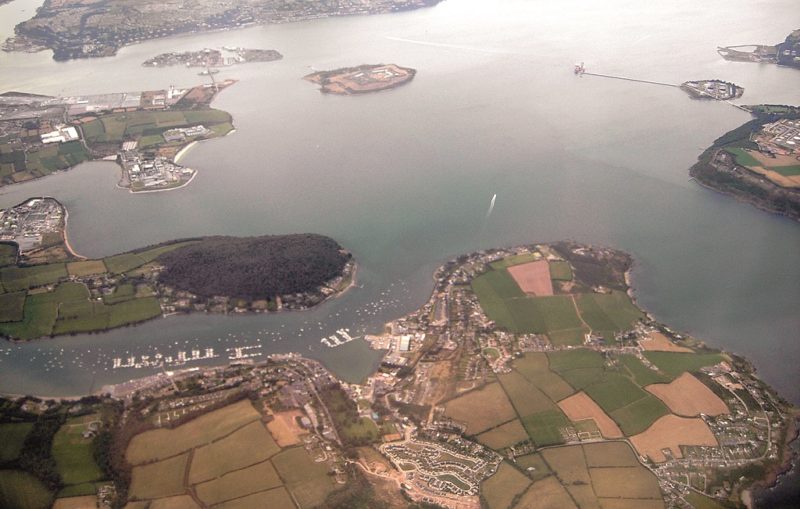
HISTORY OF CORK
The County of Cork has been colloquially referred to as ‘The Rebel Country’ since the 15th century, and more particularly the prominent role that the City of Cork played in the Irish War of Independence (1919-1921) when it was the scene of considerable fighting, and also politically during the Anti-Treaty period as a stronghold during the Irish Civil War (1922-1923). Much has been made of the role that Dublin played in these bloody civil wars, but Cork was equally rebellious, until in 1932 the Republican leader Eamonn De Valera became President of the Irish Free State, and then it severed all links with Britain. In 1937, Southern Ireland was renamed Eire, and then in 1949 the Republic of Ireland.
In 1920, half of the entire City of Cork was burnt down in the fighting, with fighting and rioting across the South Gate Bridge, an old humpback bridge that links the south side of Cork to the city centre. It has a bricked-up dungeon entrance under its arch, where criminals were executed and had their heads displayed on spikes on top of the South Gate Prison to deter anyone else from committing crimes. The houses, streets and grand buildings were not rebuilt afterwards in the style more keeping with the distinctive character of Cork people. Cork is the second city of the Republic of Ireland after Dublin and is built on a wide area of the marshes of the River Lee, which flows through it. Indeed, in Gaelic, Cork means ‘marsh’, not the tree substance that has bottled wine all over the world for centuries. The people of Cork lived a ‘clan’ existence for centuries in olden days, and inter-married within these clans.
Cork owes the most modern shopping street in the Republic of Cork to a tragedy of ‘The Troubles’ on 11th December 1920 when the area was burnt down during severe fighting with the Black and Tans constables of the Royal Irish Constabulary (RIC), recruitment for which began in Britain in January 1920 in reprisals for IRA attacks. Over 300 buildings were destroyed, and many other small towns and villages around the County of Cork suffered a similar fate including Fermoy. However, St. Patrick’s Street was rebuilt into a fine shopping street as the ‘Regent Street of Ireland’.
During the Irish Civil War (1922-1923), most of the IRA units in Cork sided with the Anglo-Irish Treaty, and from July to August 1922 they held the city and county as part of the so-called Munster Republic. However, Cork was retaken by troops of the Irish Free State in August 1922 in the Irish Free State offensive, with both overland and seaborne attacks. The city and county of Cork saw further sporadic guerrilla attacks until the Ant-Treaty side called a ceasefire and dumped their weapons in May 1923. Michael Collins (1890-1922), Irish politician and Sinn Fein leader, and a key figure in the War of Independence, was born near Clonakilty and assassinated during a Republican ambush during the Civil War at Beal na Blath in West Cork after he had successfully negotiated the Peace Treaty with Britain in 1921.
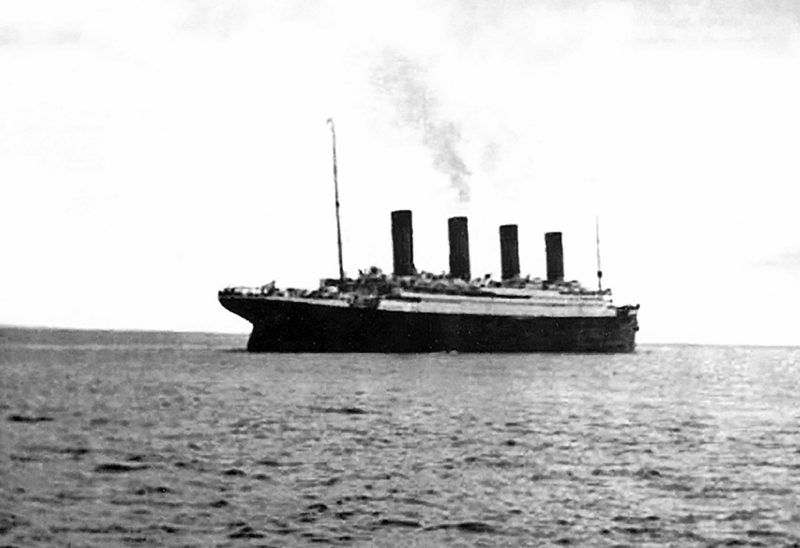
Tourists are invited to kiss the Blarney Stone five miles north west of Cork. The kiss is supposed to confer eloquence (‘gift of the gab’) on the visitor, but this is a difficult manoeuvre to perform as it involves lying on one’s back in a downward ‘slot’ or hole, with one’s ankles or feet firmly held by another person, and iron bars across the bottom of the ‘slot’ to prevent a precipitous fall from the ramparts of Blarney Castle. Tourists are also supposed to hear the Bells of Shandon, which echo and sound all over the River Lee at Cork.
Cobh was for many decades the port of embarkation for emigrants bound for the United States of America, Canada, Australia, New Zealand, South Africa and other countries. The serious potato blight disease of 1845/46 brought famine to Southern Ireland, with one million people dying, and a further 1.6 million people emigrated to start a better life elsewhere. It was also the last stop for the tragic four funnelled White Star liner Titanic, which four days later hit an iceberg on 15th April 1912 and sank with the loss of 1,512 lives. The Cunard liner Lusitania, sister of the Mauretania, was torpedoed and sunk by U-20 at 1415 hours on 7th May 1915 while on a voyage from New York to Liverpool when 11.5 miles off the Old Head of Kinsale, near to Cork with 1,193 people killed and 761 survivors. What is a lesser known fact is that stoker George Beauchamp survived both of these tragic sinkings and was able to continue his seagoing career.
Local Cork fishing boats brought most of the survivors of Lusitania and the bodies of the dead into Queenstown (Cobh). The following day, the local coroner, John Hogan, opened an inquest into the sinking, and his verdict was that the deceased had drowned following an attack on an unarmed non-combatant liner contrary to international law. The explosion of the torpedo under the starboard wing of the navigating bridge was greater because coal dust ignited in her bunker spaces, which were mostly empty of coal as she was nearing the end of her voyage. An enquiry later in London concluded that she had not carried explosives on her last voyage in her forward hold.
Today, Cork has expanded with dairies, breweries and agricultural products such as barley, as well as beer and whiskey exports. Cork is home to the oldest yacht club in the world, the Royal Cork Yacht Club in Crosshaven. There had been a ferry service from Cork to Swansea for decades, and this vital link briefly re-opened in 2010/11 to allow tourists and visitors to take a shorter route from England and South Wales. The City of Cork is administered by Cork City Council, while the County of Cork is administered by Cork County Council. The population of the City of Cork in 1950 was 80,000, in 1970 it was 132,000 and had risen to 199,230 in the 2011 census, and 210,000 in 2020, with double that number living throughout the County of Cork. The largest shopping centre in Munster Province with over 75 shops is the Mahon Point Shopping Centre in Cork, and the city has many pharmaceutical and medical companies and plants to the east of the harbour to provide employment.
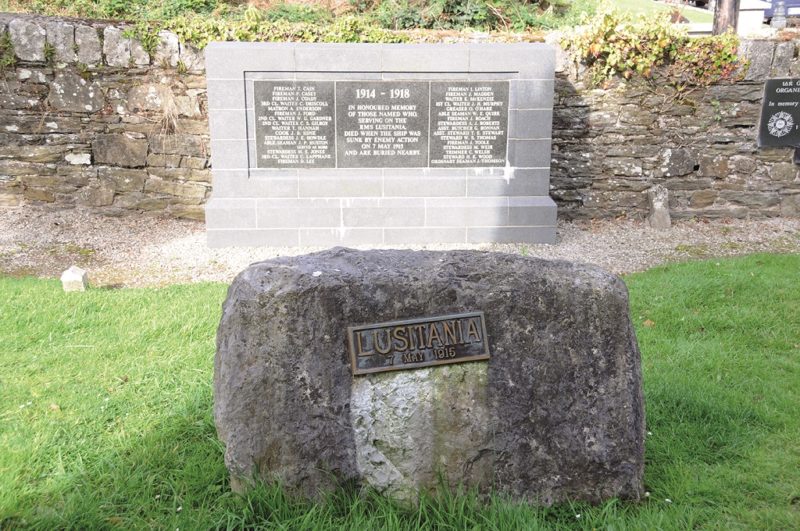
THE PORT OF CORK and BANTRY
Cork Harbour Commissioners was founded on 21st September 1814 and in 1904 they moved into their fine Custom House on Custom House Street and Quay and built an extension to the building which consisted of an elegant Boardroom and overhead offices. The Port of Cork Company Head Office remains situated in Custom House today, the Cork Harbour Commissioners assets, management, control, operation and development having been transferred to this company following the Harbours Act of 1996.
The Port of Cork established very strong links with the European Economic Community (EEC) and the European Commission and has had ferry links with Continental countries lasting over fifty years. In 1972, a Development Plan was produced for the future development of the port which would include new passenger, cars and freight berths such as the Ringaskiddy Ro-Ro Berths of 360 metres in length, and in operation by the late 1970s. The Port of Cork had a dozen berths in operation when the Ringaskiddy site was being developed, as follows:-
Lower Harbour
- Whitegate Marine Oil Terminal on the east side of an L-shaped jetty with 366 metres between the outer dolphins. Depths along the outer berth of 12.2 metres and 11.0 metres along the inner berth for vessels up to 122 metres in length. Tank capacity of 17,000 tonnes, with ballast water and oil slops taken at rates of up 1,000 tonnes per hour and a processing rate of 150 tonnes per hour.
- Cobh Roadstead Quay in front of the town had depths varying from 4.2 metres to 5.6 metres.
- Haulbowline Island to south of Cobh had a private installation that served the steel works of Irish Steel with three berths. Spencer Jetty of 107.0 metres in length and 6.8 metres alongside depth, The Basin of 152.0 metres in length and 5.3 metres alongside depth, and the Bunker Berth of 76.0 metres in length and 8.4 metres alongside depth.
- Pfizer’s Jetty projecting north east from Ballybricken Point with a pier head of 64.0 metres in length and with 844 metres between the outer dolphins and a 10.5 metre alongside depth.
- The large Verolme Shipyard with alongside depths of 7.3 metres along its fitting out quays and graving dry-dock of length 165.0 metres and two floating docks of up to 10,800 tonnes lift capacity. Four cranes of 40 tonnes capacity for erection of prefabricated sections on berths.
- Marino Point ammonia and urea plant of Irish Fertiliser Industries (IFI) at the north end of West Passage had a T-shaped jetty of 237.0 metres in length and an alongside depth of 11.5 metres, with a 380 metres distance between the outer dolphins. The plant used natural gas as fuel from the Kinsale Field off the Cork coastline.
-
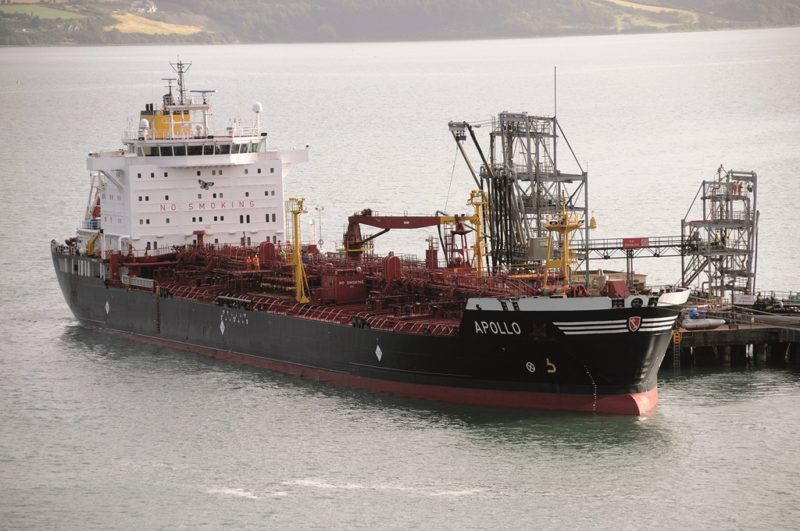
The Whitegate Marine Oil Terminal with the 23,998dwt tanker Apollo of Carl Buttner Gmbh unloading. The Apollo was built in 2003 by 3 Maj Brodogradiliste at Rijeka. (Nigel Lawrence)
Cork Harbour and River Lee
Cattle Pier with an alongside depth of 5.5 metres, and also equipped with pipelines for the discharge of petrol, LPG and caustic soda.
Ferry Berth with a ramp for ro-ro traffic and a maximum load of 65 tonnes
Unit Load Quay of length 275.0 metres and alongside depth of 8.8 metres for handling unit load and general cargo using a container crane of 30 tonnes lift and a straddle carrier of 30 tonnes lift.
Roofchrome Ltd. Jetty with mobile conveyor equipment, and a length of 152.0 metres and an alongside depth of 8.8 metres.
Cork City Quays of alongside depths of 4.6 to 5.7 metres and connected to the Irish Railway System, including Penrose Quay, the B + I berth of length 146.0 metres.
John J. Hogan Wharf on the north side of the Lee and west of the turning circle of length 200 metres and an alongside depth of 8.8 metres.
John F. Kennedy Quay on the south side of the Lee and west of the turning circle of length 200 metres and an alongside depth of 8.8 metres.

The port cargo handling equipment consisted of a container crane of 30 tonnes lift, a straddle carrier of 30 tonnes lift, a fixed transporter crane of 25 tonnes lift, four luffing grab cranes of four tonnes, and a small mobile crane.
Private wharves had cranes of lift capacity from 2.0 to 25.0 tonnes. Grain storage capacity was 85,000 tonnes, cold storage capacity of 125,000 cubic metres, and warehouses and transit sheds of 50,000 square metres.
The Lower Harbour was dredged to a depth of 14.6 metres, and Spit Bank Bar to 11.6 metres. The Harbour Commissioners Repair Yard had facilities for the repair of its dredgers and tugs including a grid iron of 91.0 metres in length, and a patent slip with a 36.5 metre cradle.
Imports included coal, general cargo, fruit and bananas, cereals, crude oil, foodstuffs, feedstock, fertilisers, iron and steel, manganese ore, magnesite, molasses, timber, LPG and other gases, with a total of imports at 3.0 million tonnes per year. Exports included general cargo, acids, ammonia, dairy products, fertilizers, magnesite, petrol and oil products, ceramic refractory goods, and urea with a total of exports of 1.5 million tonnes per annum.
The Ringaskiddy passenger and freight ro-ro berths were in use in 1982, but two years later the town suffered severe unemployment with the closure of the Cork Verolme Dockyard, and the associated Irish Shipping Ltd., as well as Dunlop, Fords and other factories.
The Harbours Act of 1996 changed the relationship of the port with the Irish Government, and in Millennium year, the port began redevelopment with the first investment of a total investment of €2 million made during the last twenty years to improve the port infrastructure and facilities. The redevelopment of Ringaskiddy ro-ro berths gained planning permission in May 2015, as larger passenger and freight ro-ros owned by Cobelfret (CLDN) and Brittany Ferries carried much larger loads of lorries and trailers in the logistics trades. A new container terminal will be built at Ringaskiddy with an initial berth of 360 metres in length, plus improvements to internal roads and the external port entrance.
The former Irish Fertiliser Industries (IFI) site at Marino Point was acquired by Belvelly Marine Development Company (BMDC) in 2017. BMDC is a public/private partnership between Lanber Holdings and the Port of Cork Company, with a view to redevelop the site as the Belvelly Port Facility, with one client from the Cork City Quays having already moved there.
A joint planning application for general cargo ships to use the existing jetty and for the building of another jetty is under consideration.

CURRENT PORT TRAFFIC STATISTICS
The Port of Cork Head Office is located at position 51°48′ North, 8°16′ West, with port total traffic holding up during the last ten years, and container traffic having increased by over 50%.
Year Total Containers (TEU)
2012 9.05 Mtonnes 165,000
2013 9.12 Mtonnes 170,000
2014 10.15 Mtonnes 191,000
2015 11.02 Mtonnes 206,000
2016 9.55 Mtonnes 210,000
2017 10.30 Mtonnes 218,000
2018 10.65 Mtonnes 229,000
2019 10.18 Mtonnes 240,186

2020 10.58 Mtonnes 250,209
- Port of Cork and Bantry turnover for the year 2020 was €33.7 million and a profit of €6.1 million, compared to a year earlier of €37.7 million and €7.3 million respectively.
- Oil storage at the Zenith Energy Whiddy Island Terminal in Bantry Bay increased by 81% to 1.3 million tonnes in 2020 compared to 0.73 million tonnes in 2019.
- Oil through traffic at Whitegate Oil Terminal decreased slightly in 2020 to 4.6 million tonnes compared to 4.7 million tonnes in 2019.
- Dry bulk of animal feed, cereals and fertlisers in 2020 increased by 3% to 1.42 million tonnes compared to 1.39 million tonnes in 2019.
- Unfortunately, all cruise traffic was cancelled in 2020 due to COVID-19 restrictions, and Brittany Ferries deferred all sailings until July 2020.
The facilities of the current Port of Cork operations are situated at four distinct locations within the Cobh and Cork harbour areas, as well as private wharfs. These are in use 24 hours per day, seven days per week, with lengths and alongside depths in metres:-
CORK CITY QUAYS
- Albert Quay 135.0 5.6
- South Jetties 411.5 8.8 (Grain silos of 69,000 tonnes capacity)
- South Deepwater Quay 194.0 6.0 (Grain silos of 22,000 tonnes capacity
- Penrose Quay 146.0 3.6
- Hogan’s Wharf 205.7 8.8
- Custom House Quay 177.0 7.3
TIVOLI
- Ro-Ro Terminal 125.0 5.5
- Container Terminal 155.0 8.8
- General Purpose Berth 170.0 8.8
- Bulk Liquid Berth 115.8 6.0
RINGASKIDDY
- Deep Water Terminal 485.0 13.4 2 Gantry, 2 Liebherr 550 mobile cranes
- Ro-Ro No 1 ramp 180.0 9.2
- Ro-Ro No 2 ramp 150.0 8.5
- General Purpose Berth 259.1 9.6
COBH
- Deep Water Quay 183.0 6.1 Cruise ship berth
PRIVATE WHARVES
- Whitegate Oil Terminal 1 365.8 13.1 Oil tank Capacity of 17,000 tonnes
- Whitegate Oil Terminal 2 106.7 10.2 Oil tank Capacity of 8,000 tonnes
- Passage West 274.3 9.0 Grain silos of 15,000 tonnes capacity
The port also provides pilotage, towage, channel dredging as well as land and property rental. The port had three dredgers in the 1970s in Grabwell of 251 grt, Loughmahon II of 250 grt and Ringacoltig of 400 grt, as well as the motor tug Shandon of 110 grt built in 1959, the former Flying Dolphin of the Clyde fleet, and a former ‘Tid’ tug. The modern motor tug Gerry O’Sullivan of 338 grt was built in 1996. The current Cork harbour fleet is operated by Celtic Tugs, formed in Cork on 1st July 1993, and had three powerful tugs in 2016 in Celtic Rebel of 309 grt and 3,500 bhp with 48 tonnes bollard pull and built in Japan in 1984, Celtic Fergus of 197 grt and 45 tonnes bollard pull, which arrived at Ringaskiddy on 1st April 2016 on a heavy lift ship and was lifted into the water on a cradle, and Celtic Banner, which served Shannon Foynes Port for sixteen years.
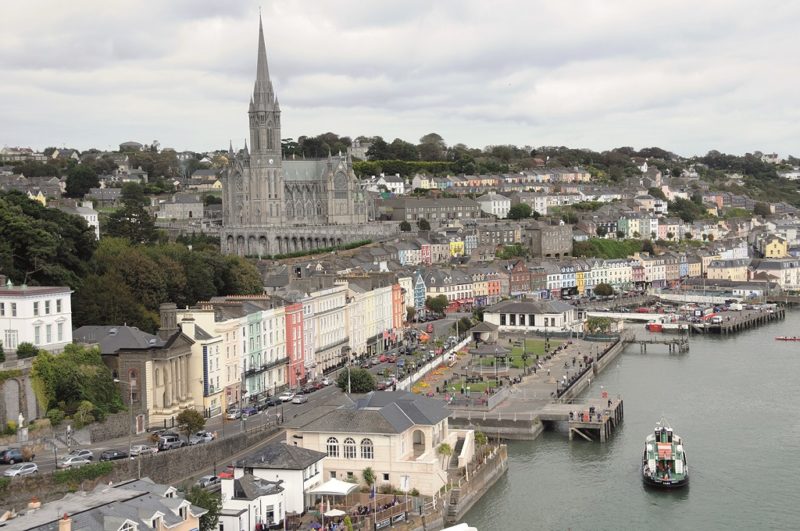
The shipbuilding and ship repair site at Rushbrooke on the east bank of the Lower West Passage had begun in 1860. When Irish Shipping Ltd. (ISL) was founded in 1941, a wholly owned subsidiary was set up by the Irish Department of Industry and Commerce as Cork Dockyard Ltd. to take over the operation of the Rushbrooke dockyard. The yard became the Verolme Cork Dockyard in 1959 when Cornelis Verolme took it over, having been attracted by Irish Government financial support, and he later also owned a yard in Brazil to develop Verolme into a worldwide shipbuilding and repair business.
Cornelis Verolme had been born on 4th September 1900 in the village of Nieuwe-Tongue in Holland, and he began in business at Hengelo in 1928 to manufacture Stork diesel engines. Many Dutch families were brought over to Cork and settled into the Cobh community, and today their descendants are part of the local fabric of the area. The yard built 33 vessels and some offshore oil platform modules, from 1960 to closure in 1984, mostly for Irish companies including Irish Shipping Ltd. (ISL), B + I Line including the final Leinster ferry, Arklow Shipping, and Lauritzen of Denmark with the large bulker Irena Dan. Five patrol vessels were also built for the Irish Government. The yard had a workforce of 1,200 men out of a total Verolme workforce of 12,000, with the company having 80% of the Dutch shipbuilding sector. The Verolme empire finally collapsed in 1984 due to a weak demand and increasing competition from low wage shipbuilding countries in Japan, South Korea and other countries.
The yard had two building berths, number 1 could build ships up to 35,000 dwt, and number 2 could built ships up to 65,000 dwt. The dry-dock could take ships up to 60,000 dwt, and there were two floating docks, the smaller for ships up to 4,500 dwt and the larger for ships up to 25,000 dwt. There were twin 40 tonne berth erection cranes, a 12 tonne dry-dock crane, a 10 tonne steel stockyard crane and a 20 tonne floating crane. The details of the two building berths were:-
No. 1 Berth No. 2 Berth
- Length 200.81 metres 227.60 metres
- Max breadth 30.02 metres 34.25 metres
- Declivity 1:20 1:21
- Concrete piles 554 917
- Weight of piles 1,293t 2,139t
- Concrete Total 6,100 m3 6,100 m3
The first ship built by Verolme Cork Dockyard (VCD) was the bulker Irish Rowan of 15,530 dwt in 1962, followed for the same owner of Irish Shipping Ltd. (ISL) the bulker Irish Elm of 38,333 dwt in 1968, the Open Hatch Gantry Crane forestry carrier Irish Stardust of 29,030 dwt in 1970, and the penultimate vessel from the yard in the Panamax bulker Irish Spruce of 71,927 dwt in 1983. Irish Spruce had been built at the Cork shipyard at a cost vastly in excess of world shipbuilding prices by a political decision of the Irish Government to keep the Rushbrooke workforce in employment, with 24% of the cost coming from Orient Leasing Inc. of Japan. She was owned by Jura Shipping Ltd. and was never owned by ISL, with the lease payments guaranteed by the Irish Minister for Finance.
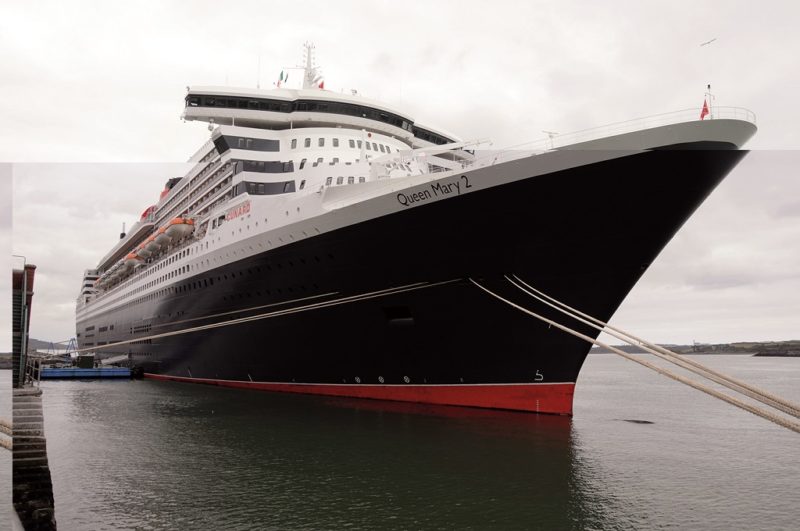
The maiden voyage of Irish Spruce in August 1983 was with coal from Newport News to Hunterston on charter to British Steel Corporation under Capt. E. Greevy. She then ballasted back to Norfolk (VA) to load grain for Ghent. She had to make an unscheduled call at Jacksonville (Florida) and another at Halifax (NS) for repairs to her rudder. She continued trading from Europe to the Gulf of Mexico until the Irish Government put ISL into liquidation in 1984, and the vessels were arrested one by one during the course of the year. Irish Spruce had been moved to Yorkhill Quay on the Clyde for repair work but was laid up there for some months. The complex legal moves of the ISL liquidation necessitated a further move of the ship to Marseille, her costs there were £34,000 per week for crew costs, port costs and stores. She was sold in 1986 to Greek owners for $5.0 million at a public auction and renamed Eagle, becoming Nephele in 1987, and Bintang Biru in 1997, and was later broken up.
Passenger and freight ferries were built for B + I Line, including Leinster launched on 19th November 1968 with accommodation for 1,200 passengers and 240 cars, and the freight ferry Dundalk of 2,353 grt built in 1974 to carry 350 cars, and Connacht of 6,807 grt launched on 20th June 1978 with accommodation for 1,500 passengers and 536 cars, and finally her sister Leinster launched in November 1980 and completed in June 1981. Five patrol vessels were built for the Irish Government including Le Aoife (P22) built in 1978, and Le Eithne (P31), the last vessel from the yard in 1984. The patrol vessel Le Niamh (P52) was in the dry-dock at Rushbrooke for repair work when a group of former employees returned for a visit in 2013, the yard having been kept in commission for repair work with the prefabricated sheds, two cranes and fitting-out shops in good order. The former employees unveiled a plaque dedicated to all former shipyard workers at the Rushbrooke site from 1860.
After the yard was closed, the large floating dock Goliath Atlantic was sold to Singapore Dockyard for further use, and was transported there on a large barge. A later development was the final assembly of Liebherr cranes built at Killarney and brought to Cork for assembly. The heavy lift ship HHL Lagos, built in 2011 and owned by Hansa Heavy Lift, sailed away with the last two of these cranes bound for Hull. Two tugs escorted her from the yard past Monkstown Bay on the opposite bank and round Black Point to Cobh and the open sea.
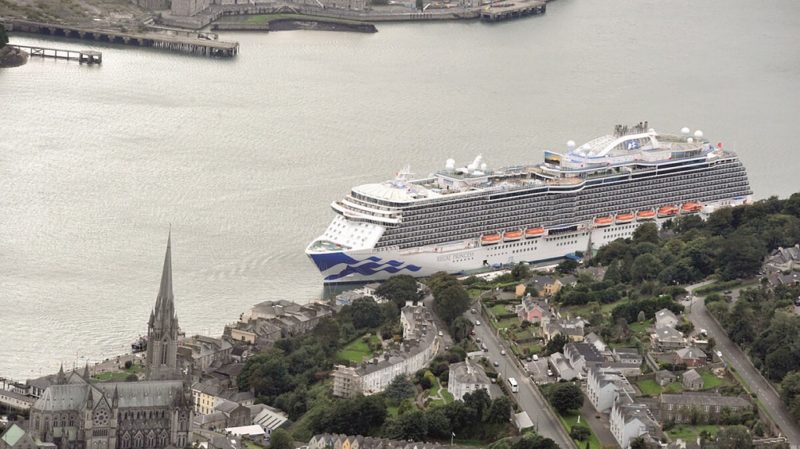
PASSENGER SERVICES FROM CORK TO ENGLAND and WALES
These historic services date back two hundred years to the famous St. George’s Steam Packet Company formed in 1821 for Liverpool to Glasgow services and also out of Hull and other ports. In 1843, this company had begun to encounter financial difficulties and by October of that year the venture had been organised into the City of Cork Steam Packet Company with Ebenezer Pike (1806-1883) as both Chairman and Managing Director, and with a capital of £170,000 of which he was the principal shareholder. Water Street and Hargreaves Quay were the berths in Cork, with Penrose Quay used later.
On 12th September 1872, the company was made into one of limited liability, and inherited nine ships with ‘bird’ names from the original company to run the coastal routes from Cork to Cardiff, Newport and London, with the associated Cork Steamship Company running to Continental ports from Cork. Steamers such as Bandon of 1,229 grt built in 1894 by Blackwood & Gordon at Port Glasgow, Glengariff of 1,286 grt built by Wigham Richardson & Company at Newcastle, Cumbria of 627 grt built in 1896 by the Ailsa Shipbuilding Company at Troon, and Claddagh of 640 grt built in 1907 by William Harkess & Son at Middlesbrough were then built or purchased. The twin funnelled Inniscarra built by Wigham Richardson & Company at Newcastle in 1903 was torpedoed and sunk by U86 on 12th May 1918 when ten miles south of Ballycotton Island, County Cork with the loss of 28 lives.
Sir Alfred Read, who had formed Coast Lines on 30th September 1913 from three coastal liner companies, purchased a controlling interest in 1918/19 in both the City of Cork Steam Packet Company and the City of Dublin Steam Packet Company. He merged the City of Dublin Steam Packet Company into the British & Irish Steam Packet Co. Ltd. (B + I), founded in 1836 and taken over in 1914 by himself. However, the City of Cork Steam Packet Company was not similarly merged into B + I until 1936 and its ships retained their white funnels with black tops. Two new passenger vessels were then completed in 1921 as Kenmare and Ardmore for the City of Cork Steam Packet Company and ran from Cork to Liverpool to give a fleet of eight ships.
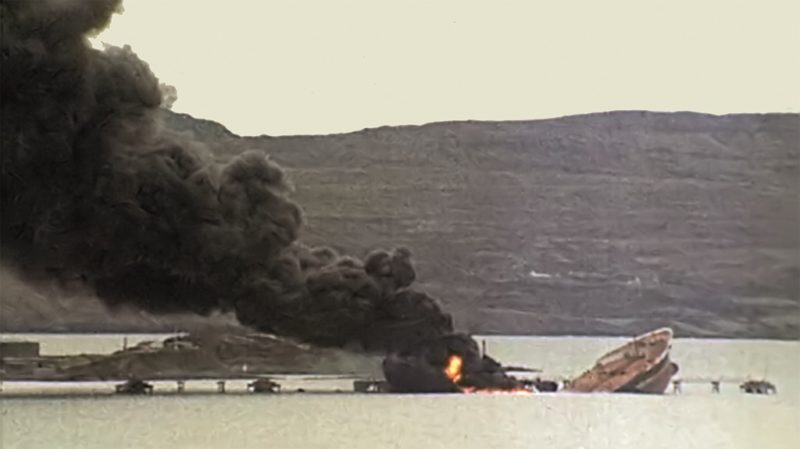
The twin screw motor passenger vessel Innsfallen of 3,071 grt was completed by Harland & Wolff Ltd. at Belfast for the Cork to Fishguard service with a service speed of 17 knots. She became part of the fleet of the B + I when the City of Cork Steam Packet Co. Ltd. was reconstituted. She was lost on 21st December 1940 when she was mined and sunk off Canada Dock entrance in the Mersey while on a voyage from Liverpool to Dublin, four crew were lost but all 148 passengers and the remainder of the crew were saved.
A new motor passenger vessel Innisfallen (2) of 3,705 grt was completed by the Denny yard on the Clyde in 1948 for service from Cork to Fishguard, and was part of the B + I fleet in 1965 when transfer of ownership of this famous company was transferred to the Irish Government. She was replaced by the new passenger motor vessel Innisfallen (3) of 4,850 grt in 1969 from the Nobiskrug yard at Rendsburg, who also completed her sister Munster (3), with the third sister coming from the Verolme Cork Dockyard (VCD) as Leinster (3) for B + I. Leinster (3) was renamed Innisfallen (4) in 1980 for the Cork to Pembroke route, after B + I had operated the ten hour service from Cork to Swansea from 1969 to 1979. The three sisters only differed slightly on the capacity of their car decks.
In the 1970s, the B + I vessels sailed from a new ferry terminal based at Tivoli Docks instead of Penrose Quay in the Cork City quays. A move to another new ferry terminal at Ringaskiddy ro-ro berths in the Lower Harbour was made in the early 1980s. The Cork to Pembroke service of B + I ended in 1983, and Cork Harbour Commissioners and the British Transport Docks Board at Swansea commissioned a report entitled ‘The Emerald Gateway’, hoping that a new ferry entrant would come forward to continue the service. This occurred four years later when Swansea Cork Car Ferries Ltd. was formed by Cork Corporation, Cork County Council and Kerry Council in Ireland, and West Glamorgan County Council and Swansea City Council in Wales. The chartered ferry Celtic Pride of 10,241 grt arrived at Ringaskiddy on 13th April 1987 for the first time for the service to Swansea. The ten hour voyage was usually covered by an overnight sailing arriving in Ringaskiddy early in the morning, sailing back to Swansea during daytime in July and August and at night for the rest of the year.
Celtic Pride also operated a mid-week return service to Roscoff for Brittany Ferries in addition to its South Wales sailings. Sealink and B + I were unhappy with the new entrant, as Celtic Pride had a non-EEC crew. She repeated her success in the 1988 season, but did not run in the 1989 season as a larger ferry with bigger freight capacity was needed. The Greek ferry Ionian Sun of 7,311 grt arrived at Cork in May 1990 as the replacement, and observers were quick to point out that she had been built at Cork as the car ferry Leinster (3) in 1968, and renamed as Innisfallen (4) in 1980, and then sold to Strintzis Lines of Greece in 1986. Ionian Sun only operated for Swansea Cork Car Ferries during the 1990 season.
She was replaced in 1991 by the returning Celtic Pride in early March 1991, which also ran the Brittany Ferries route from Cork and Roscoff from 15th March at weekends until a Brittany Ferries vessel was available in May. Celtic Pride repeated this diversion from Cork to Roscoff at weekends in Autumn 1991. The 1992 season saw Celtic Pride run again for Swansea Cork Car Ferries, the opposition from Rosslare by Stena Sealink with Stena Felicity and by B + I by Isle of Innisfree to Pembroke had not taken passengers away from the Cork to Swansea service.
Swansea Cork Car Ferries was sold in October 1992 to Strintzis Lines of Greece, operators of Ionian Sun, and sent their Superferry of 14,797 grt with accommodation for 1,355 passengers and space for 550 cars on her car deck for the 1993 season starting in March of that year and ending in January of the following year when the ferry returned to Greece for overhaul. This arrangement continued until the 1999 season when Strintzis sold Swansea Cork Car Ferries to an Irish consortium. Superferry ran alongside the former North Sea DFDS ferry Dana Hafnia for Cork St. Malo Ferries for the 1999 season, but only Superferry reappeared for the 2000 season.
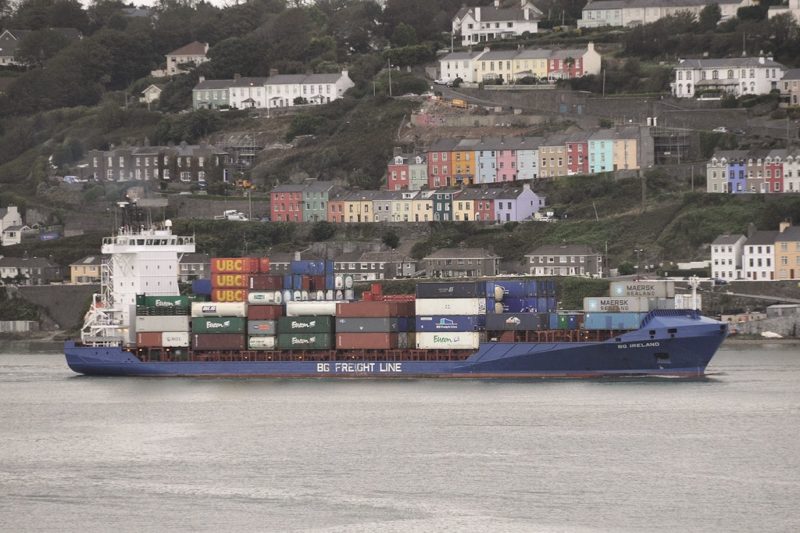
A different Mediterranean ferry was chartered for the 2001 season in Egnatia II of 7,984 grt owned by Hellenic Mediterranean Lines, renamed as City of Cork. She was well known in Irish waters as Saint Patrick II for Irish Ferries route between Rosslare in Ireland and France. City of Cork was returned to her owners in November 2000 and was not chartered again in 2001. Superferry reappeared in 2001 for the Cork to Swansea service, and no longer sailed back to Greece for annual overhaul, this being done at Dublin instead. Superferry remained on the Cork to Swansea service until she made her last sailing from Cork on 7th October 2006. Swansea Cork Car Ferries was placed in liquidation and 165 staff lost their jobs.
No ferries ran from Cork to Swansea in the 2007, 2008 and 2009 seasons, but in 2010 a new ferry company Fastnet Line was formed with a €3 million loan. The Finnish ferry Julia of 21,699 grt and built in 1982 with ten decks and accommodation for 1,860 passengers and space for 440 cars and thirty lorries on her car decks. She began her service on 10th March 2010 from Swansea to Ringaskiddy, but after running for the 2010 and 2011 seasons, it was announced that this Cork ferry passenger service would be closed permanently due to high fuel costs.
PASSENGER SERVICES FROM CORK TO FRANCE
Brittany Ferries was founded in 1972 by Alexis Gourvennec (died 2007) of St. Malo and a group of fellow Breton farmers to export their cauliflowers and artichokes to the U.K. The entry of the U.K. into the European Common Market in 1973 provided the springboard for economic trade for the new ferry company, and ended the isolation of Brittany from across the English Channel. The first freight ferry was Kerisnel of 1,983 grt and she operated from Roscoff to Plymouth. Important services from Caen to Portsmouth were later introduced, and by 1999 a fleet of seven passenger and freight ro-ros were operating carrying 2.65 million passengers and 175,000 freight units including trailers and containers.
Brittany Ferries first appeared in Cork with a summer service to France in 1987, and in 1999, an upgraded Cork to Roscoff route was introduced by the company using the passenger and freight ro-ro Val de Loire. The first ever direct route from Ireland to Spain began in 2018 from Cork to Santander using the chartered Connemara of 27,414 grt and built in 2017, but the service ended in January 2020. The current Cork to Roscoff passenger sailings are on Saturday afternoons to arrive in Roscoff on Sunday mornings using Pont-Aven of 40,859 grt, built in 2004 with a service speed of 27 knots, and also run from Cork on Wednesday afternoons to arrive in Roscoff on Thursday mornings on Armorique of 29,468 grt and built in 2009 with an equally good service speed of 25 knots. There are also two weekly freight only sailings from Cork to Roscoff, and the passenger and freight ro-ro Cotentin of 22,307 grt and built in 2007 runs on the Rosslare to Le Havre service.
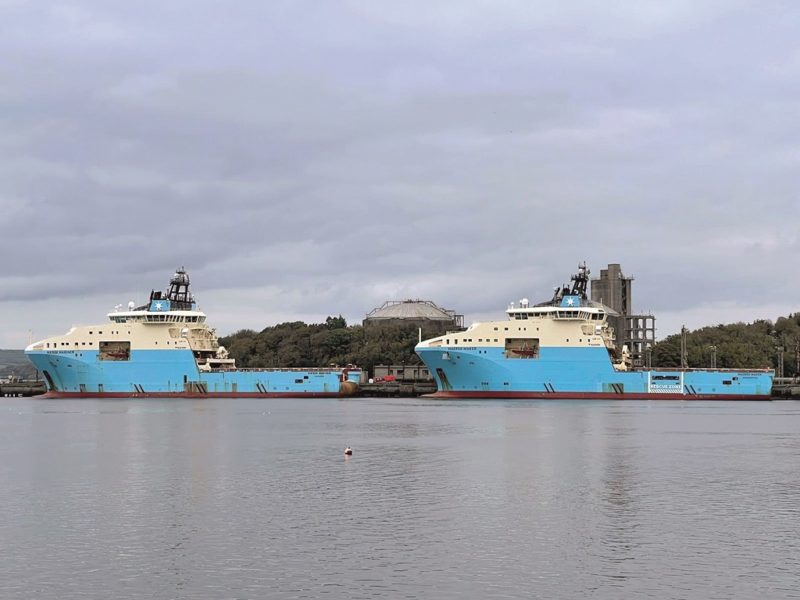
WHIDDY ISLAND OIL TERMINAL AT BANTRY BAY
The Gulf Oil Corporation of New York began construction of a large oil terminal in the mid 1960s on Whiddy Island on the south side of Bantry Bay to store crude oil from the Middle East that arrived in Gulf Oil VLCCs of 250,000 dwt. Gulf Oil had begun the transport of oil from Maracaibo and the Middle East in early post-war years with a fleet of thirty war built ‘T2’ tankers of 16,560 dwt, and then moved to a larger group of ‘supertanker’ of 32,500 dwt in 1957. VLCC crude oil tankers of 317,995 dwt entered service for Gulf Oil in 1972 when their international tanker fleet under the American, British, Belgian and Dutch flags had reached a total of fifty tankers of over 2.5 million dwt.
The French tanker Betelgeuse of 121,432 dwt owned by the Total Oil Group under Compagnie Navale des Petroles of Paris had been completed in 1968 at Saint Nazaire by Chantiers de l’Atlantique with a service speed of 16.2 knots. The Bantry Bay Oil Terminal opened in May 1969, and ten years later the tanker Betelgeuse exploded in the early hours of 8th January 1979 with disastrous fireball explosions that completely engulfed the jetty and killed 50 people including 42 French crew, 7 Irish men and one British national. She had sailed with a full cargo of crude oil in November 1978 from the Persian Gulf bound for Leixoes in Portugal. A first call at Sines oil terminal to lighten ship was abandoned due to heavy weather and the sinking of a ship in the narrow channel to the south of Lisbon.
Betelgeuse then headed for Whiddy Island at the head of Bantry Bay, and changed some crew at Vigo, but after encountering heavy weather in the Bay of Biscay she arrived on 4th January 1979 at the anchorage further down Bantry Bay, and then berthed at Whiddy Island ‘T’ shaped jetty of 1,200 feet in length at 2000 hours on 6th January. The explosion and heavy loss of life was the worst maritime disaster in Irish history. The terminal was never fully repaired and remains largely as a mass of mangled steel, and the shore oil tanks were transferred to the Irish Government in 1986 to hold much of the Irish strategic oil reserve. Tankers waiting to berth at Whiddy Island berth at one of four anchorages at Shot Head off Bere Island, further down Bantry Bay. These are at positions 51°39′ North 09°40′ West, 51° 39′ North 09°42′ West, 51°38′ North 09°41′ West, and 51°38′ North 09°39′ West.
Whiddy Island is low lying with a population of less than twenty people today as the pilchard industry of former times in the 1840s saw the population increase to 720 people and then the pilchards completely disappeared. Glengariff Harbour to the north of Whiddy Island and at the very head of Bantry Bay is more beautiful with a tourist industry in summer and up to ten expedition type small cruise ships arriving in the bay annually. Tourist attractions include:-
- Bantry House, an 18th century mansion on the south shore of Bantry Bay, once owned by the Earl of Bantry as his ancestral home, who made Grand Tours of Europe with his wife in the 1820s.
- Tranquil walks with rich naval history and historical ruins dating back to the year 1500.
- Garinish Island in Glengariff Harbour has a lovely garden with a history dating back over one hundred years and featuring a Martello Tower, a Grecian Temple and Italianate gardens. Rare plants grow well due to the temperate South West Ireland climate, and white tailed Sea Eagles fish in Glengariff Harbour.
- Walking attractions to Dursey Island, the Beara Peninsula, Mizen Head, the Sheeps Head Way, Gougane Barra with a small church and home to St. Finnbarr, Patron Saint of Cork, who arrived here after finding the source of the River Lee, that later flows out to sea at Cork.
- Cruising around Whiddy Island, only 3.5 miles long by 1.5 miles wide, and in Glengariff Harbour in local fishing boats in summer is a pleasant experience.
Cruising to Glengariff Harbour did not take place in the summers of 2020 and 2021 due to the COVID-19 pandemic, but when they return cruise ships anchor at one of two anchorages in Glengariff Harbour at position 51°43′ North 9°32′ West, and 51°44′ North 9°32′ West.
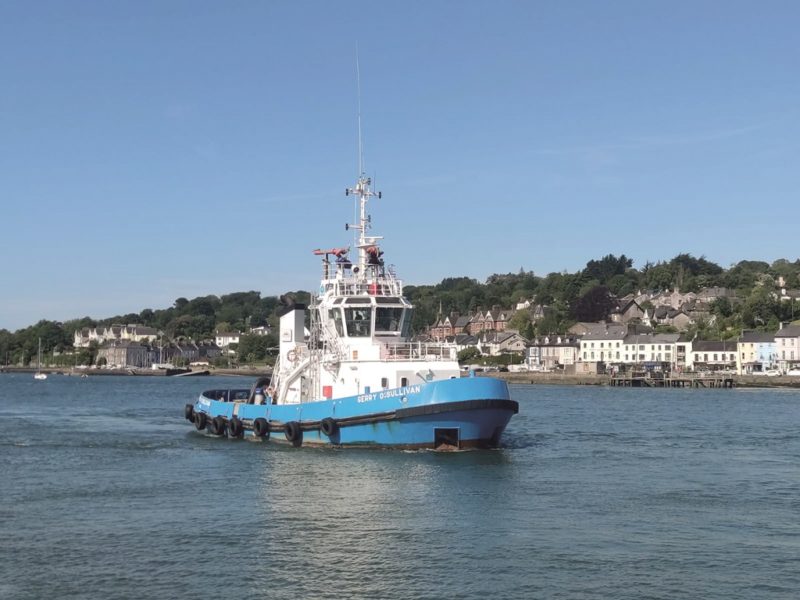
SUMMARY
The Port of Cork has a busy Lower Harbour at Cobh with up to ten commercial cargo ships arriving and sailing every day. Cruise passengers at Cobh Cruise Terminal disembark directly onto the quayside alongside the Cobh Heritage Centre, with displays about the Blarney Stone and local culture, and of the harsh living conditions in Ireland during the potato famines of 1845/46. The advances in ship design from the early ‘coffin ships’ to the adoption of the Plimsoll Line are covered, and which stopped unscrupulous shipowners sending badly unseaworthy vessels to sea in order to pocket the highly inflated insurance money that they took out, with no thought whatsoever for the many thousands of drowned crew members.
Cruise lines calling at Cork in the past have included Fred. Olsen Cruises, Princess Cruises, MSC Cruises, NCL Cruises, Royal Caribbean International (RCI), Phoenix Seereisen, Cunard Line, Hapag Cruises, Sea Cloud Cruises, Disney Cruises, Saga Cruises, Windstar Cruises, P. & O. Cruises and Celebrity Cruises, but no cruises had been confirmed for the 2022 season due to COVID-19 restrictions at the time of writing. The Victorian town of Cobh lies only 100 metres from the cruise terminal, with other local attractions include the modern Cork shopping centres, and the Fota Wildlife Park, as well as championship golf courses, and historic sailing clubs at Crosshaven.
Ringaskiddy ro-ro berths have regular twice weekly Cobelfret (CLDN) vessels of Luxembourg, such as the twin screw, twin funnelled Celandine of 23,947 grt and built in 2000, and her sister Melusine built in 1999. Grimaldi Group introduced in June 2021 a new freight service from Cork to Antwerp and Zeebrugge using the ro-ro Eurocargo Bari of 32,632 grt of length 200.0 metres and beam of 26.5 metres, and built by the Hyundai Mipo yard in South Korea in 2012, for lorries, trailers and containers. Deep sea tankers of up to 65,000 dwt can be seen at Whitegate Oil Terminal, such as the former Maersk Trenton of 49,700 dwt and now sailing as CI Huaiyang, and coastal tankers such as Sloman Hestia of 16,475 dwt of Sloman of Germany, and the former Brostrom of Sweden owned Bro Granite of 7,560 dwt and now trading as Thun Granite, as well as the green hulled chemical tanker Thun Gemini of 7,560 dwt, and the coastal tanker Bomar Quest of 8,500 dwt.
Large dry Panamax bulk carriers such as Royal Kaleido on dimensions of 229.0 by 32.0 by 8.5 metres loaded draft arrive from worldwide ports, while car carriers arrive such as Morning Laura of 6,000 car capacity, which arrived on 19th December 2021 with 682 vehicles, and car carrier Patara of 183.0 metres overall length under the German flag. Deep sea container ships such as Maersk Bahamas of 34,100 dwt and built in 2016 at Guangzhou in China, Independent Spirit of ICL Logistics, and built in 2007 of 32,250 dwt and 2,500 TEU capacity, which sails on a regular weekly service to Chester (PA) and Wilmington (NC) since 2000, with foodstuffs, beverages, healthcare products, building materials, chemicals, auto parts, paper rolls and packaging. Unifeeder and BG Freightline use feeder container ships such as Henrike Schepers and Linda of 1,200 TEU capacity berth at the Tivoli Container Terminal, while Samskip of Iceland use Samskip Express of 9,340 dwt and built in 2006. The coaster Celtic Ambassador of 5,700 dwt owned by Willie Shipping of Cardiff arrives at Ringaskiddy Terminal.
Irish Government patrol vessels use the Cork Navy Base, while summer harbour cruises around this picturesque and very large, natural deep water Lower Harbour remind one of cruising in the much warmer big navigable harbours in Southern Europe and elsewhere.




Comments
Sorry, comments are closed for this item